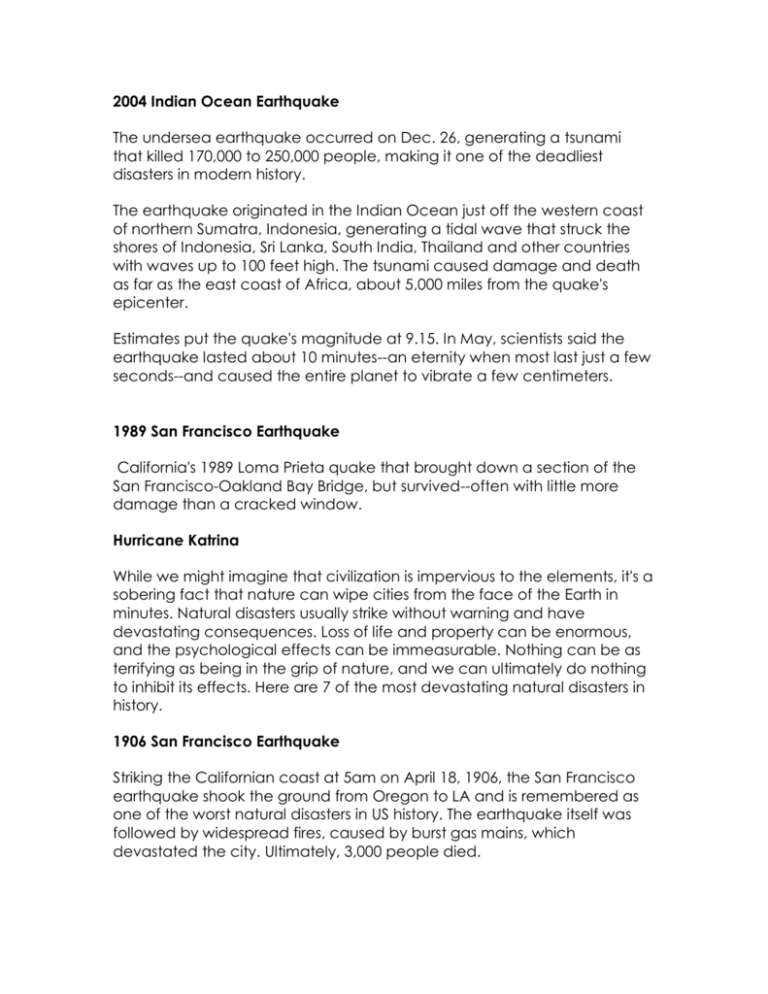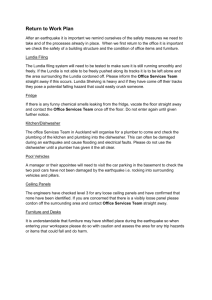list of natural disasters
advertisement

2004 Indian Ocean Earthquake The undersea earthquake occurred on Dec. 26, generating a tsunami that killed 170,000 to 250,000 people, making it one of the deadliest disasters in modern history. The earthquake originated in the Indian Ocean just off the western coast of northern Sumatra, Indonesia, generating a tidal wave that struck the shores of Indonesia, Sri Lanka, South India, Thailand and other countries with waves up to 100 feet high. The tsunami caused damage and death as far as the east coast of Africa, about 5,000 miles from the quake's epicenter. Estimates put the quake's magnitude at 9.15. In May, scientists said the earthquake lasted about 10 minutes--an eternity when most last just a few seconds--and caused the entire planet to vibrate a few centimeters. 1989 San Francisco Earthquake California's 1989 Loma Prieta quake that brought down a section of the San Francisco-Oakland Bay Bridge, but survived--often with little more damage than a cracked window. Hurricane Katrina While we might imagine that civilization is impervious to the elements, it's a sobering fact that nature can wipe cities from the face of the Earth in minutes. Natural disasters usually strike without warning and have devastating consequences. Loss of life and property can be enormous, and the psychological effects can be immeasurable. Nothing can be as terrifying as being in the grip of nature, and we can ultimately do nothing to inhibit its effects. Here are 7 of the most devastating natural disasters in history. 1906 San Francisco Earthquake Striking the Californian coast at 5am on April 18, 1906, the San Francisco earthquake shook the ground from Oregon to LA and is remembered as one of the worst natural disasters in US history. The earthquake itself was followed by widespread fires, caused by burst gas mains, which devastated the city. Ultimately, 3,000 people died. The 1931 Great Floods in China In 1931 a series of floods overran Central China. It is generally considered the deadliest natural disaster ever recorded, and almost certainly the deadliest of the 20th century, when pandemics are discounted. The human casualties are estimated to have numbered from 3.7 million to 4 million dead and countless thousands of people made homeless. The Great Tangshan Earthquake The Great Tangshan Earthquake was a natural disaster that occurred on July 28, 1976. It is believed to be the largest earthquake of the 20th century based on death toll. The epicentre of the earthquake was near Tangshan in Hebei, China, an industrial city with approximately one million inhabitants. The number of deaths initially reported by the Chinese government was 655,000, but this number has since been dropped to around 255,000. A further 164,000 people were recorded as being severely injured. The earthquake came in between a series of political events involving the Communist Party of China. It shook China both literally and figuratively in 1976, which was later labeled a 'Year of Curse'. The earthquake hit in the early morning, at 3.42am local time on July 27, and lasted for around 10 seconds. The Chinese Government’s official sources state that it reached 7.8 on the Richter magnitude scale, though some sources listed it as high as 8.2. It was followed by a major 7.8 magnitude aftershock some 16 hours later, increasing the death toll. The Bhola Cyclone of 1970 The 1970 Bhola cyclone was a devastating storm that struck Bangladesh and West Bengal on November 12, 1970. It was the deadliest tropical cyclone ever recorded, and one of the deadliest natural disasters in modern times. Up to 500,000 people lost their lives in the storm, primarily as a result of the storm surge that flooded much of the low-lying islands of the Ganges Delta. Cyclone Nargis Sri Lanka 2008 At the end of April and start of May of 2008, the Nargis Cyclone hit Sri Lanka and Burma. In Sri Lanka the flooding caused landslides in ten districts, whereas in Burma it hit the town of Bogale with over 10,000 deaths. The cyclone caused roughly $10bn in damages and over 135,000 died with over 50,000 missing. The Haitian Earthquake 2010 The 2010 Haiti earthquake was a catastrophic magnitude 7 event, with an epicentre approximately 16 miles west of capital city Port-Au-Prince. The earthquake occurred at 4.53pm local time on Tuesday, 12 January 2010. By 24 January, at least 52 aftershocks measuring 4.5 or greater had been recorded. An estimated three million people were affected by the quake; the Haitian Government reported that some 230,000 people had died, 300,000 had been injured and 1,000,000 made homeless. They also estimated that 250,000 homes and 30,000 commercial buildings had collapsed or were severely damaged. 2011 Japanese Earthquake A 8.9 magnitude earthquake slammed Japan's northeastern coast, unleashing a 33-foot tsunami on March 11. Earthquake-triggered tsunamis have spread through the waters from Japan to Hawaii and California. The 2010 Chilean Earthquake Occurred off the coast of central Chile on Saturday, 27 February 2010. It ranks as the sixth largest earthquake ever to be recorded by a seismograph. The earthquake triggered a tsunami which devastated several coastal towns in south-central Chile and damaged the port at Talcahuano. Tsunami warnings were issued in 53 countries,[10] and the wave caused minor damage in the San Diego area of California. The Eruption of Mount Saint Helens The 1980 eruption of Mount St. Helens, a stratovolcano located in Washington state, in the United States, was a major volcanic eruption. The eruption (which was a VEI 5 event) was the only significant one to occur in the contiguous 48 US states since the 1915 eruption of Lassen Peak in California.[1] The eruption was preceded by a two-month series of earthquakes and steam-venting episodes, caused by an injection of magma at shallow depth below the volcano that created a huge bulge and a fracture system on Mount St. Helens' north slope. China, 1959 Massive flooding killed an estimated 2 million people. The magnitude of the disaster wasn't new. In 1938 and 1939, flooding killed an estimated one million people. In 1931, the Yangtze River flooded, causing about 3 million deaths, including those who starved. In 1887, an estimated 900,000 people died when the Yellow River flooded. Iran, 2003 An earthquake registering 6.3 on the Richter scale flattened much of the city of Bam, killing at least 50,000 people. In 1990, a landslide triggered by an earthquake killed an estimated 50,000 in western Iran. Central America, 1998 Hurricane Mitch slammed into Nicaragua and Honduras, killing about 10,000 people and leaving more than 2 million homeless. Mudslides wiped out entire villages. Bangladesh, 1970 Storm-induced flooding killed about 300,000 people. Flooding killed about 130,000 in 1991. Colombia, 1985 The Nevada del Ruiz Volcano erupted, setting off a massive mudflow that inundated the city of Amero, killing an estimated 23,000 people. Peru, 1970 A 7.8 earthquake on Mt. Huascaran set off an avalanche that buried two towns, killing an estimated 20,000 people. Armenia, 1988 An earthquake measuring 6.9 on the Richter scale killed about 100,000 people.






